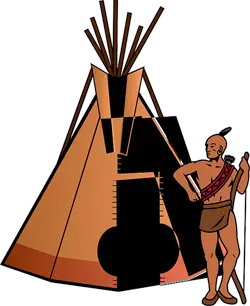Homes and Dwellings
There were many different Native American tribes in North America, and their homes were often very different. Some tribes had to build homes to withstand harsh winters. Others built homes to keep them cool in extreme heat. No matter where they were located, or what kind of climate they had, Native Americans were very creative in building homes. They used the materials that were available to them to make the best homes for their environment.


In the Great Lakes region, where forests were plentiful, they built homes called wigwams. Most wigwams were eight to ten feet tall. They were made from wooden frames and covered with woven mats and sheets of birchbark. Often wigwams were built in a dome or cone shape. Mats covered the floor, and extra mats could be added for warmth.

In the Southern Plains, some tribes built homes called grass houses. They look similar to wigwams but were made with different material. Like wigwams, they were often bent into a dome or beehive shape. Since grass is plentiful on the prairie, grass houses were thatched with long prairie grass. Grass houses could be very large, sometimes as tall as a three- or four-story building! That’s a lot of grass!

In the southeastern United States, they made wattle and daub houses. The first step in building these homes was building a frame, usually from cane, vines, or wood. The frame would then be coated clay or mud. These homes took a lot of effort to build. They also required a warm, dry climate in order to dry the mud or clay. Because so much work went into building wattle and daub houses, they were for permanent use. That meant they were well-suited to agricultural people who tended to settle in one place rather than move around.

One of the most interesting types of home is the cliff dwelling. These were built by the Anasazi in the southwestern United States. Believe it or not, they were built along the sides or under the overhangs of cliffs. Imagine having to climb a ladder to get into your house! The Anasazi did just that—they climbed a ladder onto the roof of their cliff dwelling, and then entered through an opening in the ceiling.
Cliff dwellings could be quite complex. One, known as the Cliff Palace, has more than 150 rooms beneath the rim of a canyon. Another one, Balcony House, can be reached by climbing a thirty-two foot ladder and crawling through a tunnel. If you’re wondering why the Anasazi would build homes that were so difficult to get into, the answer is simple: for protection! If they were attacked, they simply had to pull up the ladders, and no one could reach their homes!

If you want to build your own Native American home, this is the least you should know:
• Wigwams: wooden frames covered with mats or sheets of birchbark
• Grass houses: bent wooden frames thatched with long grasses
• Wattle and daub houses: wooden frames covered with clay or mud
• Cliff dwellings: built onto the top or sides of a cliff with a ladder for entry



